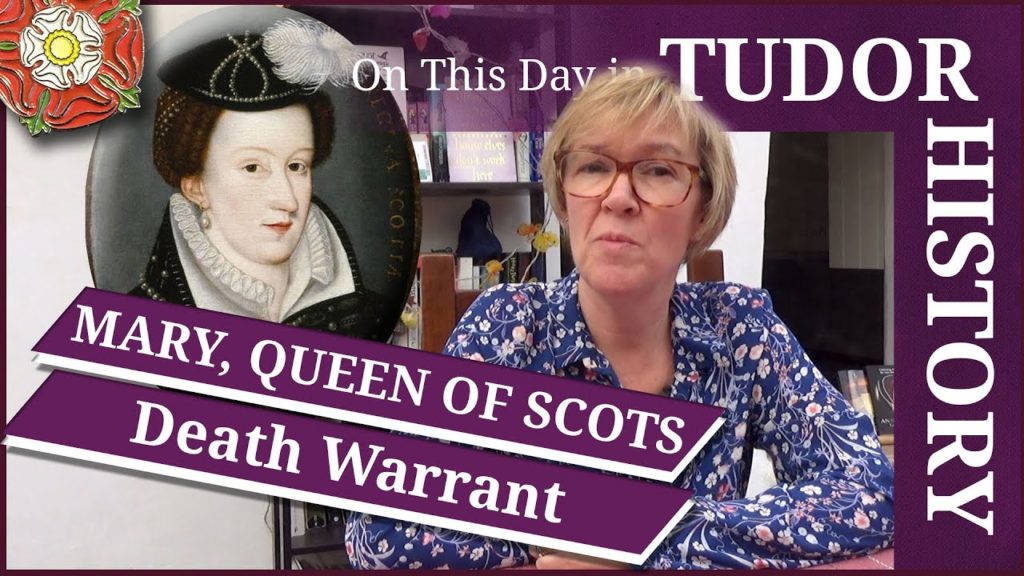On this day in Tudor history, 1st February 1587, Queen Elizabeth I called her secretary, William Davison, to her and asked him to bring her the death warrant of Mary, Queen of Scots. She then signed it. However, she didn't want it to be sent to Fotheringhay, where Mary was held, until she said so. But it was sent.
Elizabeth wanted someone else to take responsibility for Mary's death, she even wanted her gaoler to assassinate her!
Find out all about this, and how Mary DID end up being executed in February 1587, in today's talk.
Also on this day in Tudor history, 1st February 1554, Queen Mary I gave a rousing speech at the Guildhall to rally Londoners against Wyatt’s rebellion. Find out what Mary said in last year's video:
Also on this day in history:
- 1506 – Birth of George Buchanan, Scottish historian, poet, playwright, humanist scholar and administrator, at Moss Farm in Killearn, Stirling, Scotland. Buchanan's works included two tragedies: “Baptistes” and “Jephthes”, his satire “Chamaeleon”, poems and books of verses, the treatise De jure Regni apud Scotos and his Rerum Scoticarum Historia, a history of Scotland.
- 1514 – Henry VIII granted the Dukedom of Suffolk to Charles Brandon, his future brother-in-law, and also made Thomas Howard, 2nd Duke of Norfolk, and Howard's son, also Thomas, the Earl of Surrey.
- 1547 – The executors of Henry VIII's will appointed Edward Seymour, Earl of Hertford, to the offices of Lord Protector of the Realm and Governor of the King's Person.
- 1552 – Birth of Roger Cooke, alchemist and former assistant of Dr John Dee. He also appears to have been employed by Henry Percy, 9th Earl of Northumberland and a man known as the “Wizard Earl” to set up and run a still house in the Tower of London.
- 1555 – Burial of Jane Dudley, Duchess of Northumberland and wife of John Dudley, Duke of Northumberland, at Chelsea.
- 1562 – Death of Sir Richard Edgcumbe, courtier and politician. He was buried at Maker Church in Cornwall. Edgcumb served as a member of Parliament for Cornwall, High Sheriff of Devon (1543 and 1552), High Sheriff of Cornwall (1556) and Commissioner of Muster in Cornwall in 1557. In 1559, he was appointed as a Commissioner for the Royal Visitation of the Diocese of Exeter.
Transcript:
On this day in Tudor history, 1st February 1587, Queen Elizabeth I called her secretary, William Davison, to her and asked him to bring her the death warrant of Mary, Queen of Scots. She then signed it.
Mary, Queen of Scots, had been tried in October 1586 for her involvement in the Babington Plot, a plot to assassinate Queen Elizabeth I and to replace her with Mary as queen. As the trial closed, Mary demanded that she should be heard in front of Parliament or the Queen, but she was fighting a losing battle. Sentence was delayed as long as possible, by order of Elizabeth, but on 25th October the commission reconvened and found Mary guilty. On 29th October, Parliament met to discuss Mary, the Babington Plot and her role in the murder of her second husband, Henry Stuart, Lord Darnley. Parliament decided that they should petition Elizabeth to execute Mary. This put Elizabeth in a difficult position. Mary was family, being descended from Margaret Tudor, Elizabeth’s aunt, and she was a fellow monarch. Elizabeth did not want to be accused of regicide. On the 4th December, Mary was publicly proclaimed guilty.
On this day in 1587, Elizabeth called Davison to her, asking him to bring Mary's execution warrant to her to sign. Elizabeth signed it, but told Davison to ask her spymaster Sir Francis Walsingham to write to Sir Amyas Paulet, Mary's gaoler, in his own name, asking him to kill Mary. This would enable Elizabeth to be rid of Mary without taking any responsibility for her death, instead Paulet would be acting privately under the Bond of Association. Historian John Guy describes the Bond of Association as “a licence to kill”. Anyone signing the Bond, which was drawn up by Walsingham and William Cecil, Lord Burghley, in 1584 after the 1583 Throckmorton plot, was swearing to “pursue as well by force of arms as by all other means of revenge” anyone plotting to cause harm to the queen.
Paulet was understandably horrified, protesting that “God forbid that I should make so foul a shipwreck of my conscience.” Meanwhile, Cecil called a secret meeting of Elizabeth’s Privy Council and they agreed to send the signed warrant to Fotheringhay Castle, where Mary was being held. Cecil appointed the Earls of Shrewsbury and Kent to direct the execution, and the council agreed to keep Elizabeth in the dark until the deed was done.
On 8th February 1587 Mary Queen of Scots was executed at Fotheringhay. Although Elizabeth was furious with her council, so much so that Cecil fled to his home and Davison was thrown into the Tower, John Guy points out that whatever happened to Mary, whether she was assassinated or executed, Elizabeth could deny any responsibility: "She had carefully contrived things so that she would win whatever happened. If Mary was killed under the Bond of Association, Elizabeth could disclaim responsibility. If Cecil covertly sealed the warrant and sent it to Fotheringhay behind her back, she could claim she had been the victim of a court conspiracy.” Clever.
We’ll never know the truth of what happened, but Elizabeth was finally free of her enemy.
